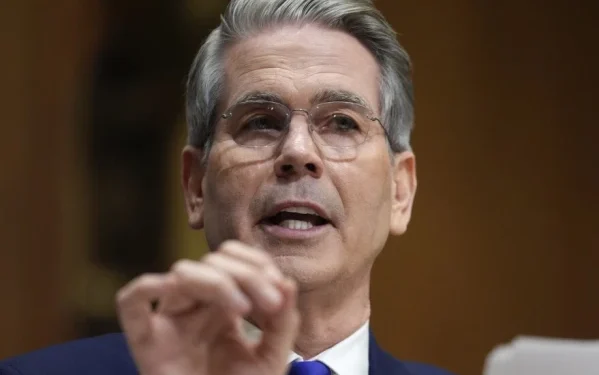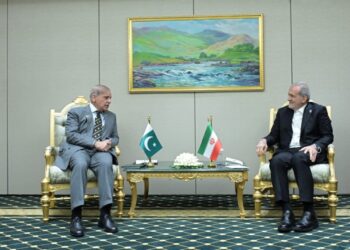Introduction
The already fragile trade relations between the United States and India have entered a new period of strain following strong remarks from US Treasury Secretary Scott Besant. Speaking to foreign media, Besant openly criticized what he described as India’s “stubborn” negotiating stance, claiming it is obstructing progress in finalizing a long-awaited trade agreement between the two countries.
The comments come at a time when Washington is also navigating sensitive trade discussions with China, working to maintain stability in South Asia, and managing the political and economic implications of high tariffs imposed under the Trump administration.
Treasury Secretary Scott Besant’s Criticism of India
In his interview, Scott Besant made it clear that patience in Washington is wearing thin over the prolonged negotiations with New Delhi. According to him, trade agreements with several countries—including Switzerland and India—are still pending despite months of diplomatic engagement.
Besant emphasized that the Trump administration was hoping to conclude these negotiations by the end of October, but India’s uncompromising position on key issues has become the main stumbling block.
He remarked:
“While we have made progress with other nations, the Indian side continues to adopt a rigid approach that is making it extremely difficult to move forward.”
The Broader Trade Negotiations Landscape
The United States has been in the process of re-evaluating and renegotiating multiple bilateral trade agreements as part of President Donald Trump’s “America First” economic strategy. The approach has often included:
- Raising tariffs to pressure trading partners into concessions.
- Renegotiating existing agreements to secure more favorable terms for US exports.
- Addressing intellectual property rights, market access, and trade imbalances.
While the US has made progress with countries such as Mexico, Canada, and Japan, talks with India have been notably more contentious.
US–India Trade Disputes: Key Issues
Experts suggest that the deadlock stems from a combination of tariff disagreements, market access disputes, and regulatory concerns. Major points of contention include:
- Tariffs on Agricultural Goods – The US seeks reduced Indian tariffs on products like dairy, almonds, and apples.
- Digital Trade Regulations – Washington is pushing back against India’s data localization requirements, which mandate that companies store certain types of data within India.
- Medical Device Pricing – The US has objected to India’s price caps on imported medical equipment.
- US Tariffs on Indian Goods – In retaliation for India’s trade policies, the US has raised import duties, further complicating negotiations.
Escalating Tariff Measures
One of the most significant developments in the ongoing dispute is the recent 25% tariff increase imposed by President Trump on Indian goods. This move has pushed the total tariff rate to 50%, affecting a wide range of Indian exports.
While the Trump administration argues that these tariffs are necessary to protect American industries and level the playing field, Indian officials see them as punitive measures that undermine trust and make negotiations more difficult.
Trade analysts warn that such escalations risk triggering a tit-for-tat trade war, which could hurt exporters on both sides.
Impact on Bilateral Trade
The United States and India maintain a significant trade relationship, with bilateral trade valued at over $140 billion annually before recent disputes. However, both sides rely heavily on exports to each other:
- India exports textiles, pharmaceuticals, machinery, and IT services to the US.
- The US exports aircraft, defense equipment, agricultural products, and high-tech goods to India.
Higher tariffs, if sustained, could disrupt supply chains, increase costs for businesses, and ultimately impact consumers in both countries.
US–China Trade Talks and Regional Diplomacy
During the same interview, Treasury Secretary Besant revealed that US officials are set to meet Chinese counterparts in the next two to three months to discuss the future of economic relations between the two countries.
Given the ongoing US–China trade tensions, these discussions will be closely watched by markets and policymakers. Any progress—or lack thereof—could indirectly influence Washington’s approach to negotiations with India.
US State Department on South Asian Stability
Amid the focus on trade, the US State Department is also addressing regional security concerns. Spokesperson Timmy Bruce highlighted that tensions between Pakistan and India had escalated recently to a point where the situation could have deteriorated into a major crisis.
Bruce credited timely diplomatic efforts by US leadership for averting what he described as a “possible disaster.”
He added:
“The United States maintains strong relations with both Pakistan and India. Our priority is to ensure peace and stability in South Asia, and we will continue to engage with both governments to that end.”
The Link Between Trade and Geopolitics
Political analysts note that trade negotiations cannot be entirely separated from geopolitical considerations. Washington’s approach to India is influenced by its desire to:
- Strengthen ties with New Delhi as a counterbalance to China.
- Maintain influence in the Indo-Pacific region.
- Support economic growth in a way that aligns with broader strategic objectives.
However, escalating trade disputes risk undermining these broader diplomatic goals.
India’s Likely Response
Although Indian officials have not yet publicly responded to Besant’s latest comments, past statements suggest that New Delhi is determined to protect its domestic industries and regulatory autonomy.
India has repeatedly emphasized the importance of mutual respect in negotiations and warned that unilateral tariff hikes are counterproductive. In the past, it has responded to US tariffs by imposing retaliatory duties on American products.
Economic and Political Ramifications
If trade talks remain stalled, the fallout could be significant:
- For Businesses – Exporters may face reduced market access, leading to revenue losses.
- For Consumers – Tariffs could result in higher prices for goods ranging from electronics to food products.
- For Diplomacy – Strained trade relations could spill over into defense and security cooperation.
Moreover, with US presidential elections approaching, trade policy is expected to remain a hot political issue, influencing how aggressively Washington pursues concessions from trading partners like India.
Historical Context: US–India Trade Relations
US–India trade ties have seen ups and downs over the past decades:
- In the early 2000s, relations improved significantly with increased cooperation in technology and defense.
- Disputes over agricultural subsidies and market access have been recurring flashpoints.
- The Generalized System of Preferences (GSP), which allowed duty-free entry for certain Indian goods into the US, was revoked in 2019, marking a turning point in relations.
The current tensions are the latest chapter in a long and complex economic relationship.
Conclusion: A Critical Juncture
The sharp words from US Treasury Secretary Scott Besant underscore the fragility of the current US–India trade relationship. With tariffs at historically high levels, and with both sides standing firm on their positions, the likelihood of a breakthrough in the immediate future appears slim.
At the same time, the United States is balancing multiple diplomatic and economic priorities, from China relations to South Asian stability, making the stakes in these trade talks even higher.
If progress is not made soon, the risk is not only a trade impasse but also a potential weakening of one of the most strategically important partnerships in the Indo-Pacific region.

























